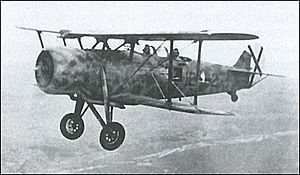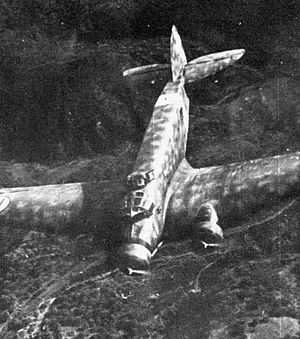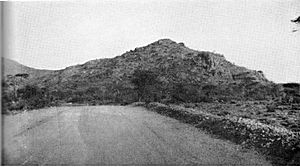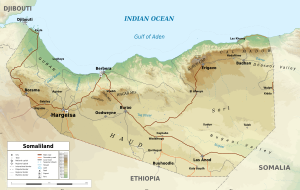Italian invasion of British Somaliland facts for kids
Quick facts for kids Italian invasion of British Somaliland |
|||||||||
|---|---|---|---|---|---|---|---|---|---|
| Part of the East African campaign of the Second World War |
|||||||||
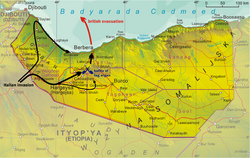 Italian conquest of British Somaliland, August 1940 |
|||||||||
|
|||||||||
| Belligerents | |||||||||
|
|
|
||||||||
| Commanders and leaders | |||||||||
|
|
||||||||
| Strength | |||||||||
| 4,507 British and Commonwealth troops (75 per cent King's African Rifles and Somali irregulars) |
24,000 Italian and colonial troops | ||||||||
| Casualties and losses | |||||||||
| Total: 2,275 British Empire: 50 killed 105 wounded 120 missing Somali (British service) c. 2,000 7 aircraft destroyed 10 aircraft damaged 1 tug lost 2 vessels damaged |
Total: 3,029
c. 1,000 4 aircraft destroyed |
||||||||
The Italian invasion of British Somaliland happened between August 3 and August 19, 1940. It was part of the East African campaign during the Second World War. Forces from Fascist Italy, including Italian, Eritrean, and Somali soldiers, attacked British Somaliland. They defeated the combined forces of Britain, the Commonwealth, and local Somali fighters.
Italy won this battle by moving quickly. However, the difficult land, rainy weather, and strong British defense slowed them down. A key fight was the Battle of Tug Argan (August 11–15). Here, Italian artillery slowly wore down the outnumbered defenders. The British commander, Major-General Reade Godwin-Austen, had to retreat towards Berbera.
The British fought a delaying action as they pulled back. The evacuation from Berbera went better than expected. The Italian advance was slowed by rain. This defeat caused problems between General Archibald Wavell, the British commander in the region, and Prime Minister Winston Churchill.
Contents
Background to the Conflict
Italian East Africa
On May 9, 1936, Italy's leader, Benito Mussolini, created Italian East Africa (AOI). This new territory combined the colonies of Italian Eritrea, Italian Somaliland, and Ethiopia, which Italy had recently conquered. On June 10, 1940, Mussolini declared war on Britain and France. This made Italian forces in Africa a threat to British supply routes. These routes ran through the Mediterranean Sea, the Suez Canal, and the Red Sea.
British Forces in the Middle East
Lieutenant-General Archibald Wavell was in charge of the new Middle East Command. This command covered the Mediterranean and Middle East. Italy had many more soldiers in Libya than Britain had in Egypt. Wavell decided that defending was the best plan. He aimed to slow down any Italian attacks. Later, British and Commonwealth forces gained a big advantage. They managed to break the secret codes used by the Italian army and air force in East Africa. This meant the British could read Italian messages.
British Somaliland: The Colony
British Somaliland was a colony with an area of about 68,000 square miles. Most of its 320,000 people raised livestock. The main town and port was Berbera. It was surrounded by desert and scrubland. Berbera was an important port, but it had no proper docks. Ships had to be unloaded using smaller boats, which took a long time. This was impossible during the hot, strong winds of July and August.
Preparing for Battle
British Defence Plans
The border of Somaliland was 750 miles long. After Italy took over Ethiopia, most of this border was next to the new Italian colony. In 1936, British plans suggested not fighting an invasion. However, the governor, Arthur Lawrence, disagreed. He wanted to defend the colony.
The British military commander, Brigadier Arthur Chater, believed a small number of extra troops could help them resist for twelve days. This would give time for help to arrive from India. By August 1939, plans changed. If France defended Djibouti, the British would retreat there. If France lost, the British would hide in the hills.

In 1940, the British decided to resist an invasion. They wanted to hold Berbera for as long as possible. The local force, the Somaliland Camel Corps (SCC), had 631 members. They had some vehicles and camels, but no heavy weapons. Reinforcements arrived in May and July. These included soldiers from Northern Rhodesia, Nyasaland, India, and the Black Watch regiment. The troops were a mix of different groups, short on artillery and transport.
The British expected Berbera to be the main target. The mountains inland had only two main roads for vehicles: through Hargeisa and Burao. Hargeisa was the more direct route through a gap called Tug Argan. The Burao road went through Sheikh Pass. Chater placed two battalions and mountain artillery at Tug Argan. The Camel Corps formed a screen to observe and delay the Italian invaders.
Italian Invasion Plans
The Italians were worried that Britain might invade through Djibouti. Aosta, the Italian commander, wanted to take Djibouti and Berbera. Mussolini approved the invasion in August. Aosta and his deputy, General Guglielmo Nasi, believed the main battle would be in the Karim and Jerato passes. They planned to surround the British defenders.
The Italian invasion force was very large. It included five colonial brigades, three Blackshirt battalions, tanks, armored cars, and many artillery guns. Lieutenant-General Carlo de Simone led the main force. Their goal was to defeat the British and occupy British Somaliland. The Italians planned three main advances:
- A central column would go through Hargeisa and Tug Argan. This would be the main attack.
- A western column would advance towards Zeila. They would then move along the coast towards Berbera.
- An eastern column would move towards Odweina and Burao. This would protect the main attack's side.
The Battle Begins
On August 1, Italian bombers attacked ships near Zeila. British planes from Aden bombed Italian airfields in return. On August 3, 1940, British planes spotted about 400 Italian soldiers crossing the border. The central Italian column moved towards Hargeisa and Tug Argan. The western column advanced on Zeila, and the eastern column went towards Odweina.
On August 4, the central column moved towards Hargeisa. The Somaliland Camel Corps (SCC) fought small battles to slow them down. Italian planes attacked Berbera. British planes also attacked Italian columns. On August 5, the Italian invasion force took Hargeisa. Italian planes continued to bomb British positions. British planes attacked Italian columns, and one British plane was shot down.
The eastern Italian column reached Odweina on August 6. The SCC and local police fought delaying actions as British forces pulled back to Tug Argan. Twelve Italian light tanks advanced, but three were destroyed by British anti-tank rifles. British planes continued to fly reconnaissance and attack Italian columns.
The Italians paused at Hargeisa for two days to get organized. Then, they continued their advance towards Tug Argan. On August 8, Italian forces closed in on the British defenses. The British reported Italian medium tanks. A ship, HMAS Hobart, even sent its saluting gun to help. Italian fighters attacked British planes and airfields.
In the north, the Italian western column captured Zeila on August 10. This cut off communications with French Somaliland. They then slowly moved along the coast road towards Berbera. British ships and planes attacked them.
Major-General Reade Godwin-Austen was sent to command the British forces. He was ordered to defend Tug Argan. He arrived on August 11.
The Tug Argan Position
Tug Argan was a key defensive position. The road from Hargeisa went through the Kerim Pass to Tug Argan. The pass was a flat, rocky area with some hills. The British named these hills Black, Knobbly, Mill, and Observation hills. They had machine-gun posts and some barbed wire. The British had too few soldiers to cover the whole area. The hills were far apart, allowing attackers to pass between them.
Battle of Tug Argan
The battle for Tug Argan began on August 10. British planes bombed Italian troops. On August 11, the Italians attacked the west end of the Assa Hills. They pushed back the British defenders. Attacks on Mill and Knobbly hills failed at first. British planes continued to attack Italian positions, facing Italian fighters.
On August 12, the Italians attacked all British positions at once. By evening, Mill Hill was captured after strong resistance. The Italians now controlled the southern side of the gap. On August 13, the British on Knobbly Hill fought off another attack. However, Italian soldiers managed to sneak past the defenses. They ambushed a British convoy carrying water and ammunition.
Mussolini ordered more reserves and air support for the invasion. Italian planes bombed British positions and retreating troops. On August 14, Castle Hill and Observation Hill were heavily bombed. An attack on Observation Hill failed.
A British counter-attack at Mirgo Pass had some success but was pushed back. The Italians were close to cutting off the British supply line. The British defenders were tired after four days of fighting. There was no better place to retreat to. Godwin-Austen told his commander that further resistance at Tug Argan was useless. He believed most of the force would be lost. On August 15, Godwin-Austen was ordered to withdraw from the colony. He planned a slow retreat to Barkasan, then to Nasiyeh, and finally to Berbera.
Retreat to Berbera
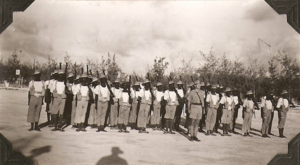
On August 15, Italian bombers continued to support their army. British planes also attacked Italian positions. After a long bombardment, the Italians took Observation Hill. During the night, the British retreated from Black, Knobbly, and Castle hills. The Black Watch and other troops formed a rearguard at Barkasan.
Italian planes attacked ships in Berbera harbor. British planes also fought Italian aircraft. On August 17, the Italians attacked the British defenders at Barkasan. The Black Watch fought back with counter-attacks. However, the Italians were close to surrounding them.
The evacuation from Berbera went well. Godwin-Austen was able to pull back his rearguard. British planes bombed the captured airfield at Hargeisa. As the Italian invasion neared its end, more Italian planes arrived.
Evacuation from Berbera
The Royal Navy had built a jetty and started evacuating civilians. On August 16, British troops began to board ships. Italian air attacks on British ships had little effect. On August 17, the Italian western column was stopped by gunfire from a British ship. After dark, the rearguard pulled back to Berbera with few losses. All troops were loaded by the early hours of August 18.
On August 18, British planes bombed Italian vehicles near Laferug. Italian fighters shot down one British plane. Later, British planes bombed the airfield at Addis Ababa. Italian troops overcame the second British defensive position near Berbera.
Before sailing for Aden on August 19, the ship Hobart stayed behind to collect any remaining soldiers. It also helped destroy buildings, vehicles, and fuel. The tugboat Queen was the only British ship lost; its crew sank it. The Royal Navy evacuated 7,140 people, including 5,690 soldiers and 1,266 civilians. Most of the Somali soldiers were sent home. The Italians did not interfere much with the evacuation. This might have been because Aosta wanted to allow the British to leave, hoping for a peace agreement. Soon after, Italian troops occupied Berbera. Much of the town was on fire. Mussolini officially made the colony part of the Italian Empire.
Aftermath of the Invasion
Losses
In 1954, a British historian reported that the British had 260 casualties (killed, wounded, or missing). He estimated Italian casualties at 2,052 men. Seven British aircraft were shot down, and ten were damaged. An Italian historian in 1988 reported that the Italians had 465 killed, 1,530 wounded, and 34 missing, totaling 2,029 men. This included 161 Italians and 1,868 local Eritrean and Somali soldiers. Somali fighters helping the British had about 2,000 casualties. About 1,000 Somali fighters on the Italian side also became casualties.
British Re-capture
On March 16, 1941, the British launched Operation Appearance from Aden. Indian Army soldiers and Somali commandos landed on both sides of Berbera. Few Italian soldiers resisted. Repairs began on the port, and supplies were moving through within a week. This greatly shortened the distance supplies had to travel by road. The British re-captured all of British Somaliland. On April 8, Brigadier Chater was made Military Governor.
See also
 In Spanish: Conquista italiana de la Somalilandia británica para niños
In Spanish: Conquista italiana de la Somalilandia británica para niños
- Eric Charles Twelves Wilson, awarded the Victoria Cross for actions at Observation Hill
- List of British military equipment of World War II
- List of Italian Army equipment in World War II
Images for kids



